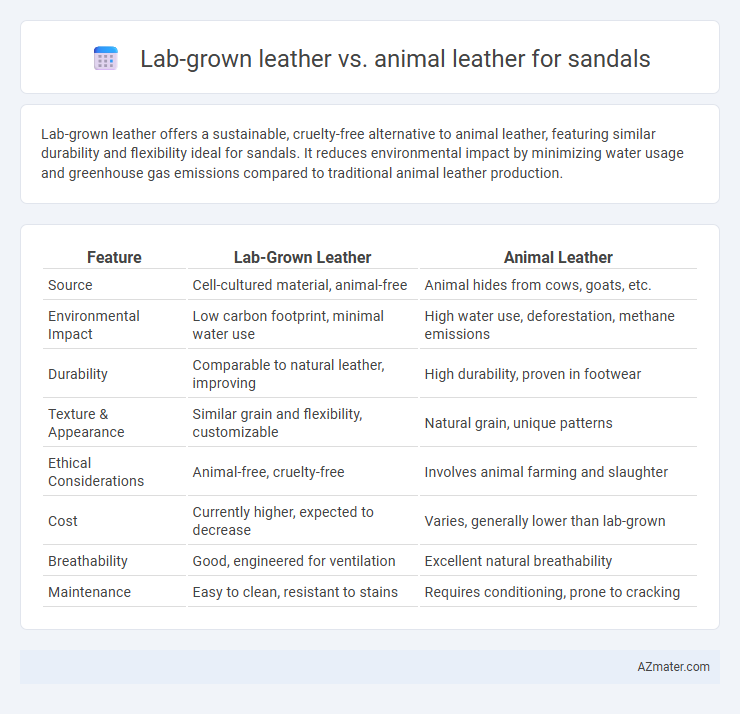Lab-grown leather offers a sustainable, cruelty-free alternative to animal leather, featuring similar durability and flexibility ideal for sandals. It reduces environmental impact by minimizing water usage and greenhouse gas emissions compared to traditional animal leather production.
Table of Comparison
| Feature | Lab-Grown Leather | Animal Leather |
|---|---|---|
| Source | Cell-cultured material, animal-free | Animal hides from cows, goats, etc. |
| Environmental Impact | Low carbon footprint, minimal water use | High water use, deforestation, methane emissions |
| Durability | Comparable to natural leather, improving | High durability, proven in footwear |
| Texture & Appearance | Similar grain and flexibility, customizable | Natural grain, unique patterns |
| Ethical Considerations | Animal-free, cruelty-free | Involves animal farming and slaughter |
| Cost | Currently higher, expected to decrease | Varies, generally lower than lab-grown |
| Breathability | Good, engineered for ventilation | Excellent natural breathability |
| Maintenance | Easy to clean, resistant to stains | Requires conditioning, prone to cracking |
Introduction: The Evolution of Sandal Materials
Lab-grown leather offers a sustainable and cruelty-free alternative to traditional animal leather in sandal production. This innovative material replicates the texture and durability of animal hide while significantly reducing environmental impact through lower water usage and greenhouse gas emissions. As consumer demand shifts toward eco-friendly products, lab-grown leather is becoming a transformative solution in the evolution of sandal materials.
What is Lab-Grown Leather?
Lab-grown leather, also known as cultivated or bio-fabricated leather, is produced by cultivating animal cells in a controlled environment without the need for livestock farming. This innovative process reduces environmental impact by minimizing water usage, deforestation, and greenhouse gas emissions associated with traditional animal leather production. In sandals, lab-grown leather offers a sustainable, cruelty-free alternative that maintains the durability and aesthetic qualities of genuine leather.
Animal Leather: Traditional Origins and Uses
Animal leather, derived from the hides of cattle, goats, and sheep, has been a staple material in sandal production for centuries due to its durability, breathability, and natural comfort. Its traditional tanning methods, including vegetable and chrome tanning, enhance flexibility and water resistance, making it ideal for everyday wear. Artisans value animal leather for its unique texture and ability to develop a distinctive patina, which adds character and longevity to sandals.
Environmental Impact: Lab-Grown vs Animal Leather
Lab-grown leather significantly reduces environmental impact compared to traditional animal leather by lowering greenhouse gas emissions, water usage, and land consumption during production. Animal leather tanning involves toxic chemicals and contributes to deforestation, soil degradation, and high carbon footprints from livestock. Choosing lab-grown leather for sandals offers a sustainable alternative with a smaller ecological footprint and less pollution.
Durability and Performance in Sandals
Lab-grown leather offers improved consistency in texture and resistance to wear, making it highly durable for sandal use compared to traditional animal leather. Its engineered properties provide enhanced water resistance and flexibility, ensuring sustained performance in various weather conditions. Animal leather, while naturally strong and breathable, can be more prone to cracking and stretching over time, especially when exposed to moisture or heavy use.
Comfort and Wearability Comparison
Lab-grown leather for sandals offers superior breathability and flexibility, resulting in enhanced comfort during extended wear compared to traditional animal leather. The consistent texture of lab-grown leather reduces break-in time and minimizes the risk of blisters or irritation. While animal leather provides durability and molds to the foot over time, lab-grown alternatives maintain shape and comfort without compromising wearability or environmental impact.
Aesthetic and Design Possibilities
Lab-grown leather offers unparalleled customization options for sandals, allowing designers to experiment with unique textures, colors, and finishes that mimic or surpass traditional animal leather's natural grain. Unlike animal leather, lab-grown materials can be engineered for uniformity and precision, enabling intricate patterns and shapes that enhance aesthetic appeal without compromising durability. These design possibilities expand creative freedom while maintaining an eco-friendly profile, making lab-grown leather a versatile and innovative choice for modern sandal production.
Ethical Considerations and Consumer Choices
Lab-grown leather offers a sustainable alternative to traditional animal leather by eliminating the need for livestock farming, reducing animal cruelty and environmental impact. Ethical consumers increasingly prefer lab-grown leather sandals due to concerns over animal welfare and deforestation linked to animal leather production. Market trends reveal a growing demand for cruelty-free, eco-friendly footwear, positioning lab-grown leather as a preferred choice for socially conscious buyers.
Cost and Market Availability
Lab-grown leather offers a cost-effective alternative to traditional animal leather for sandals, with production expenses gradually decreasing as technology advances and scale increases. Market availability of lab-grown leather is expanding swiftly, driven by sustainable fashion trends and increasing consumer demand for eco-friendly materials. Conventional animal leather remains widely available and established but faces rising ethical concerns and regulatory scrutiny, elevating its long-term costs and market constraints.
Future Trends: The Path Forward for Sandal Materials
Lab-grown leather presents a sustainable alternative to traditional animal leather by reducing environmental impact and ethical concerns in sandal production. Innovations in biomaterials and nanotechnology are driving enhanced durability and texture in lab-grown leather, making it increasingly competitive for high-quality sandal manufacturing. Market demand for cruelty-free and eco-friendly products is accelerating investment in lab-grown leather, signaling a significant shift in the future of sandal materials.

Infographic: Lab-grown leather vs Animal leather for Sandal
 azmater.com
azmater.com